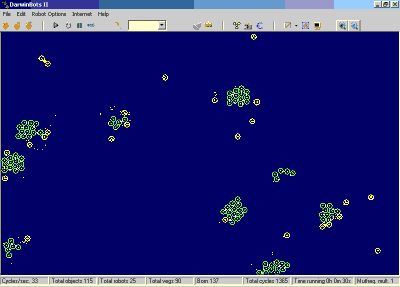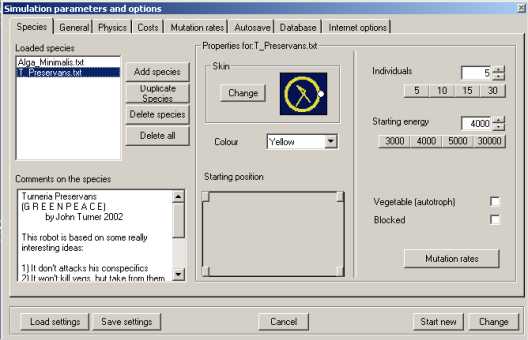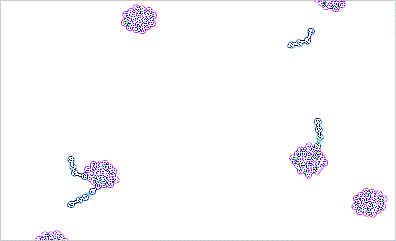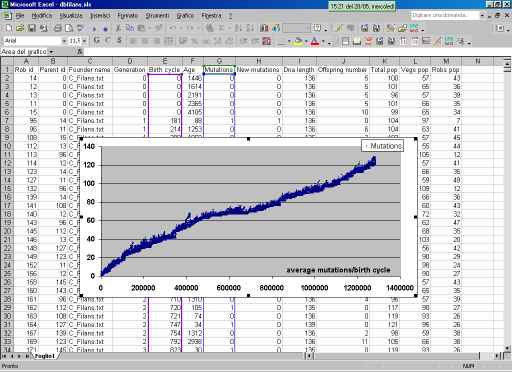
DarwinBots 2.1 screenshots.
Some screenshots from the latest version of DarwinBots, v2.1:

A tipical simulation... those yellow guys are Turneria Preservans (called this way because John Turner programmed them and they are kinda ecologist robots) eating the vegetable Alga Minimalis, in green.

A zoomed scene from the same simulation. Robots suck energy from each other by shooting "attack particles" to the victims, which, if reached, are forced to shoot them back the white energy particles. That's why you see such a mess of coloured dots. There's a banquet going on there!
Look at the two yellow bots tied at the center/bottom of the screen. These are a Turneria and his newborn child. In a few seconds the tie will break and they'll go their own way (notice also that the drawings inside them are identical: it means that no mutations occurred during the duplication process).

There are many different graphs you can display to follow the evolution of the simulation and its inhabitants. Just as an example, these are population/cycles, Average DNA mutations/cycles and average sons/ cycles. Obviously divided by species.

Other tools to play with. The single robot's data (species name, energy, age, offspring, mutations number, and so on), his complete DNA (a program written in a simple interpreted language), a console to debug it easily -just in case you want to program your own. You can even look at the robot's genes activation in real time in a winamp style :)

And this is the simulation setup window. As you can see, there are many options to tinker with.
Just to mention some of those you can't see: under the General tab, field size and geometry, population control; under Physics, friction, moving and swimming factors, brownian motion; under Costs, the energy costs/benefits ratios; under Mutation rates, a general mutation multiplier; and more: autosaving parameters, database recording, internet organisms sharing.
 Ok,
this one has been sligthly modified with Paint Shop Pro. Just an edge contour,
anyway. It looked so "microscope" this way! But the worms are true multicellular
organisms, swimming. They develop from a single egg cell, dividing many times to
form the complete body, and tieing all the child cells in a precise shape. Then
they go around swimming, eating and reproducing like any good animal should do.
Ok,
this one has been sligthly modified with Paint Shop Pro. Just an edge contour,
anyway. It looked so "microscope" this way! But the worms are true multicellular
organisms, swimming. They develop from a single egg cell, dividing many times to
form the complete body, and tieing all the child cells in a precise shape. Then
they go around swimming, eating and reproducing like any good animal should do.
It took me a week to program them!
 This is what you can get by reloading the database files generated by DarwinBots
into Excel or in a database software. For example, this scatter graph shows each
robot with a point P=(x,y)=(birth cycle, accumulated mutations). For each robot, birth cycle, mutations, dna length and so on have
been recorded.
This is what you can get by reloading the database files generated by DarwinBots
into Excel or in a database software. For example, this scatter graph shows each
robot with a point P=(x,y)=(birth cycle, accumulated mutations). For each robot, birth cycle, mutations, dna length and so on have
been recorded.